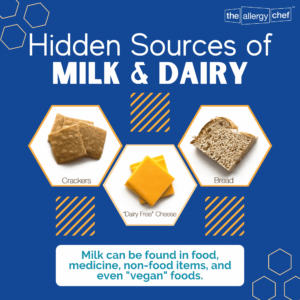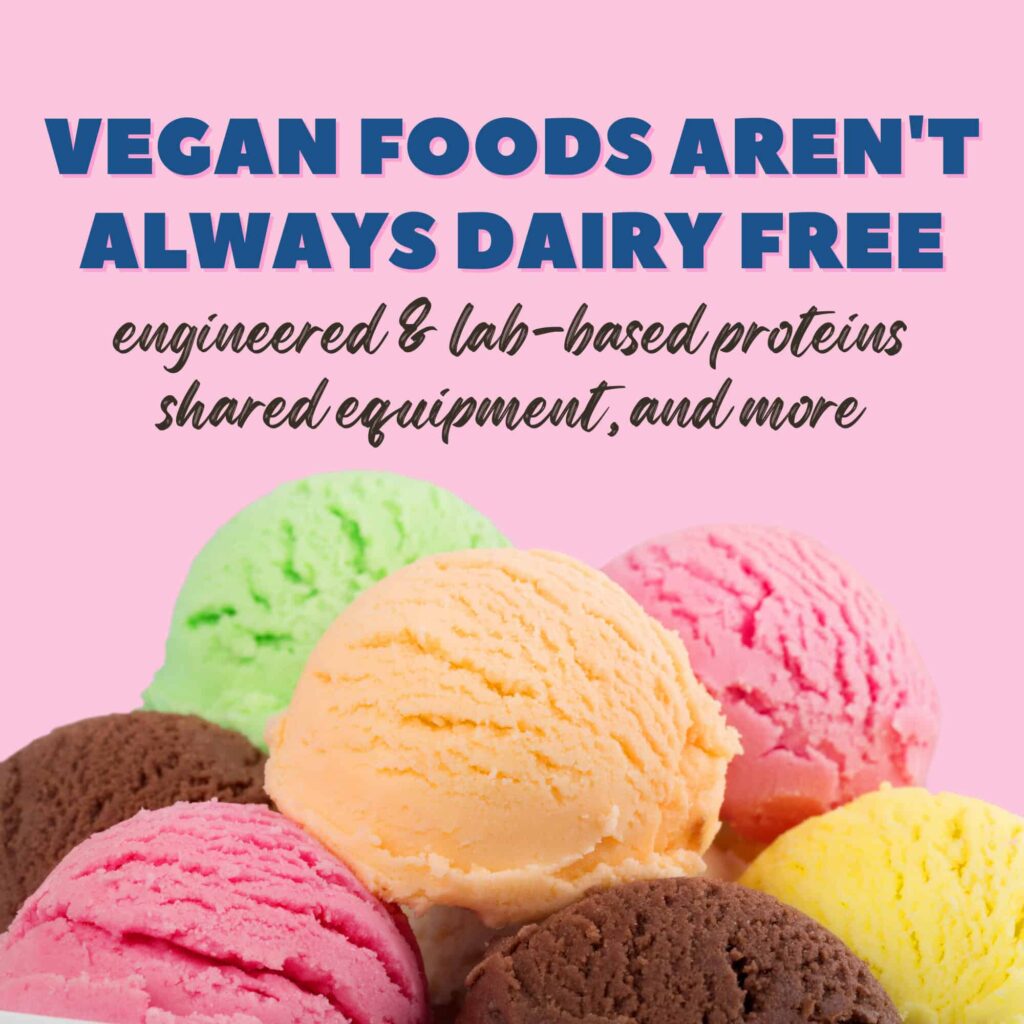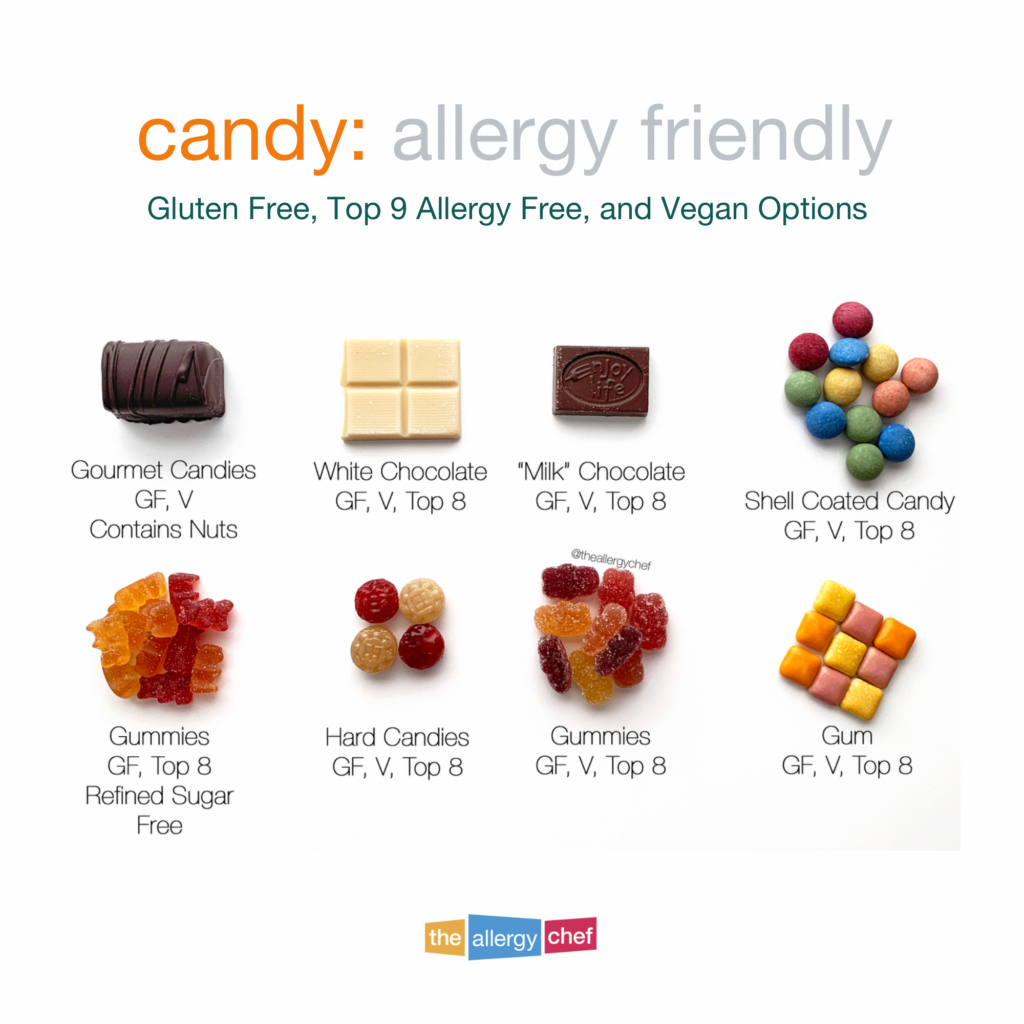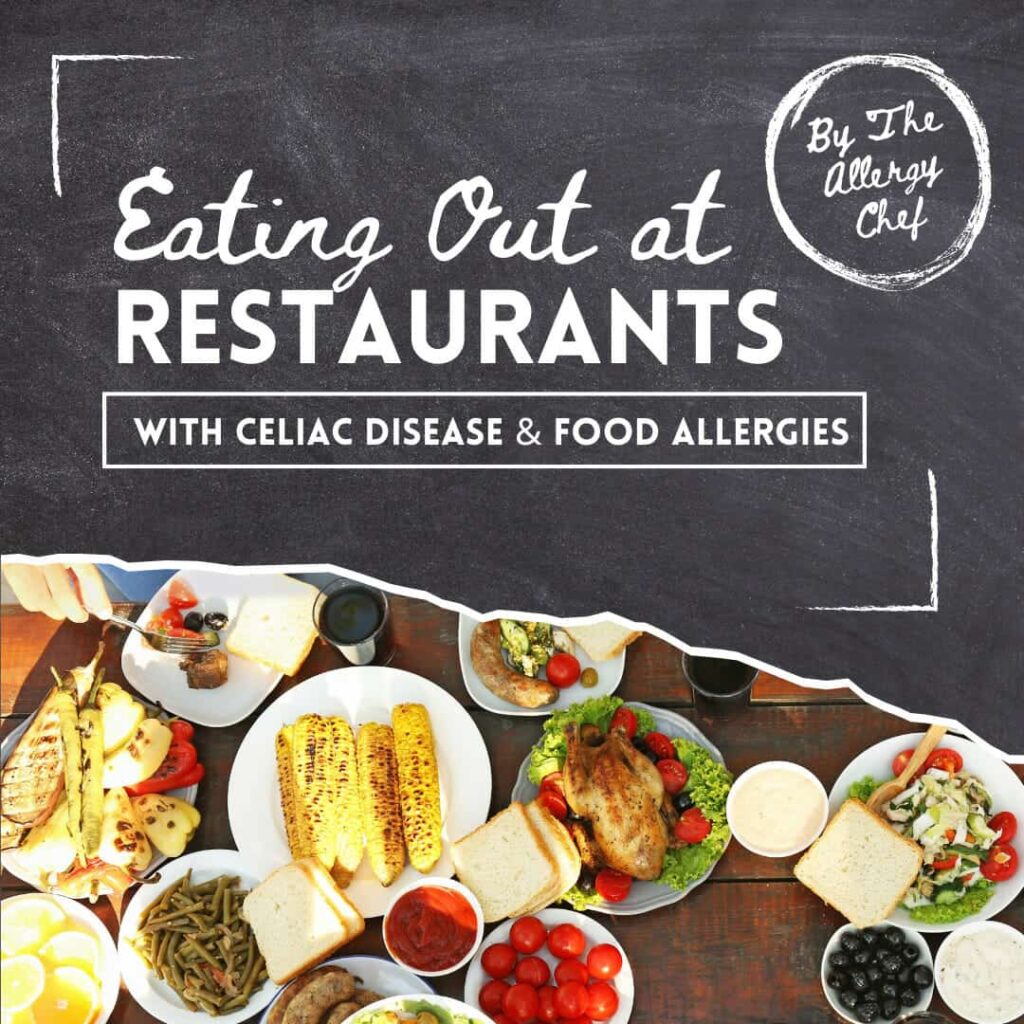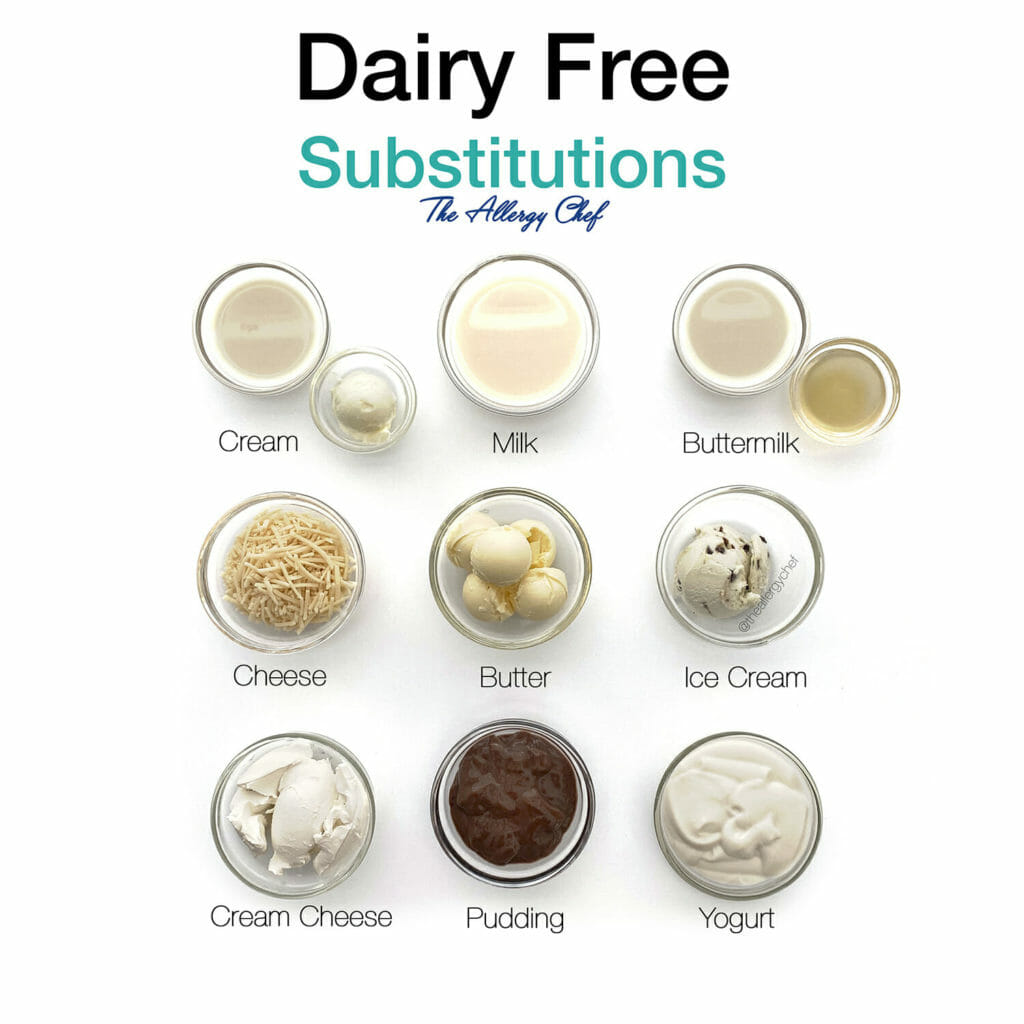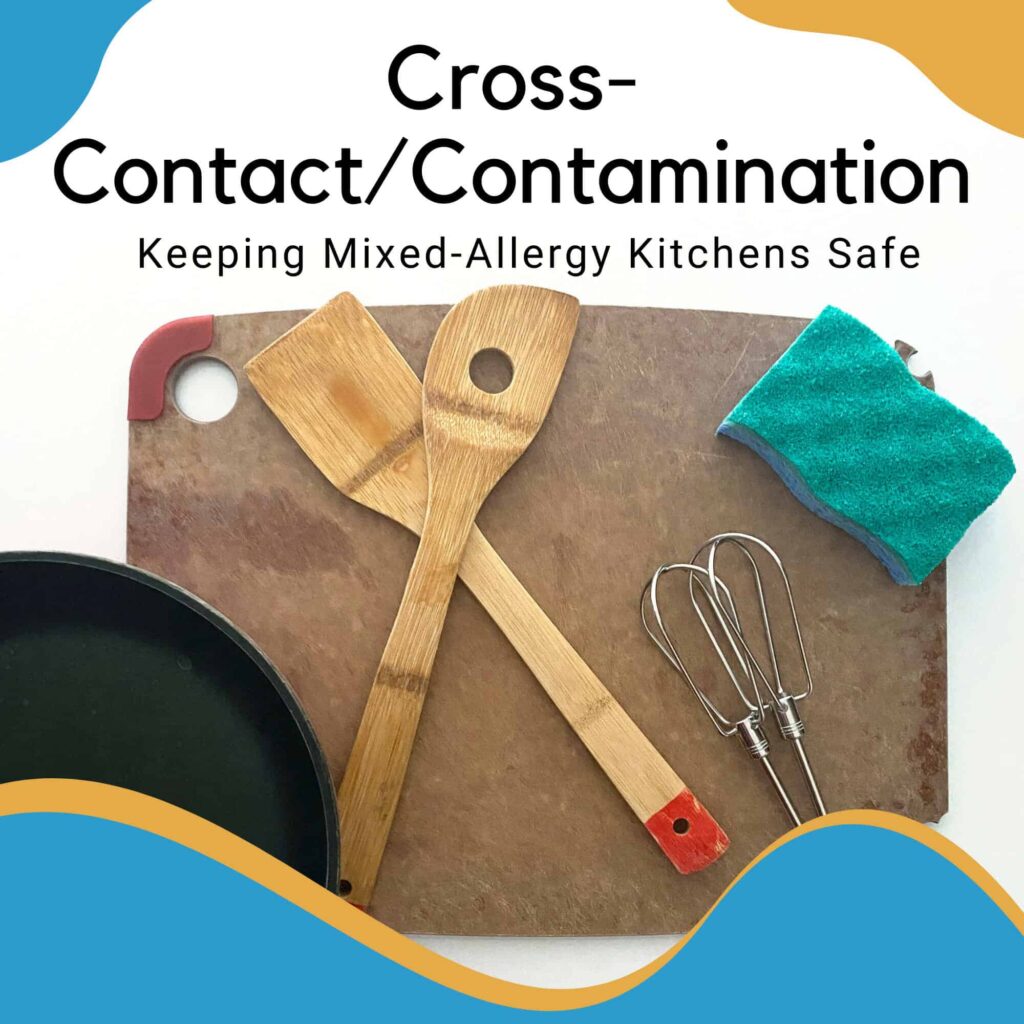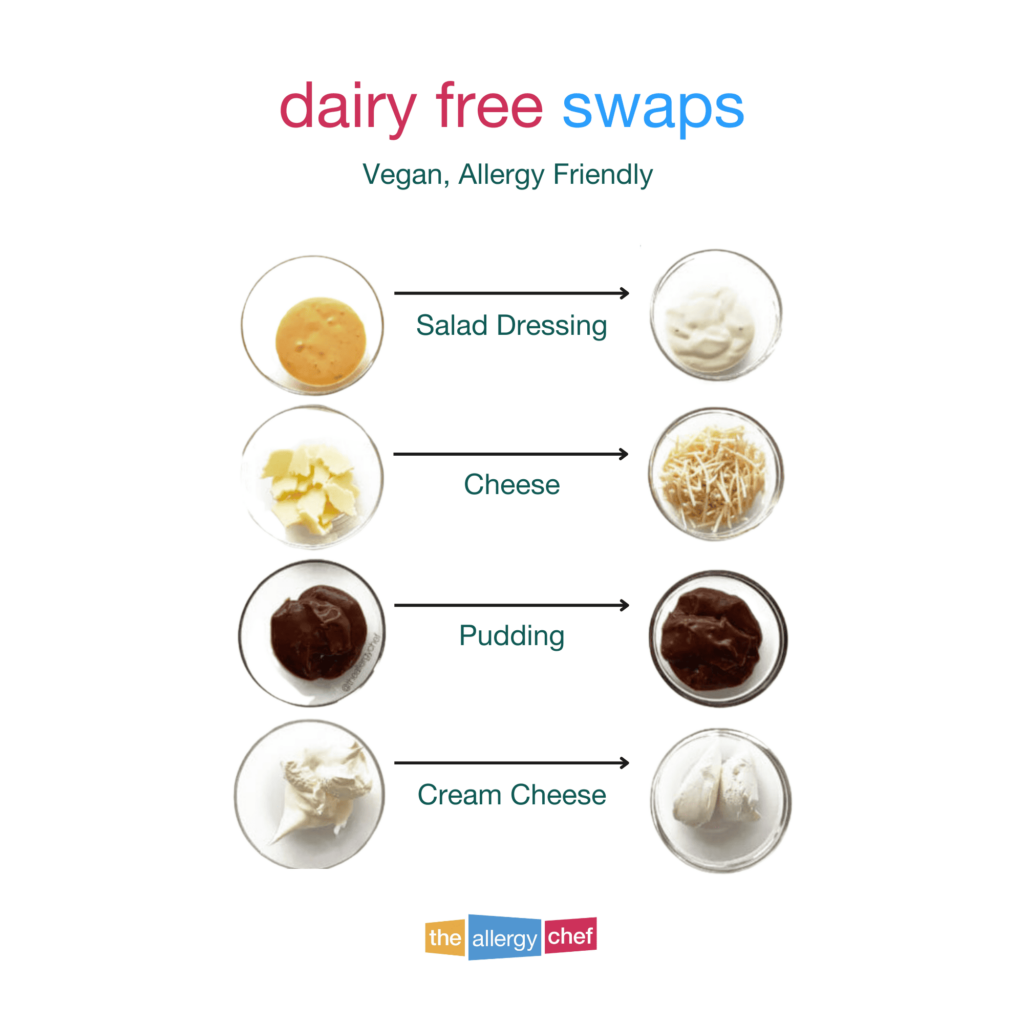Being diagnosed with a milk allergy can feel like climbing Mount Everest when you’re new. Milk ingredients and dairy products are found in just about every aisle in grocery stores (yup, even bath and body). Not only that, but there are so many names for dairy ingredients that just don’t sound like milk.
Today we’re going to take a look at all the different names for milk ingredients, hidden sources of milk and dairy, parts of milk to be aware of, cross-contact (sometimes called cross-contamination) and what it means to manage a food allergy. By the time you reach the end of this article you’re going to be ready to hit the ground running and avoid the hidden sources of milk like a real pro.
What is a Food Allergy?
A food allergy is a response by your immune system that’s triggered by a protein that your body sees as a threat. This is not the same thing as a food intolerance or an autoimmune disease. If you suspect you have a food allergy, ask your healthcare provider or doctor to refer you to an allergist where a blood test and/or skin prick test can be ordered to determine if you have an allergy. Know that tests are not 100% accurate, but are still a good diagnostic tool.
A “true” food allergy is IgE mediated, and the immune system usually elicits a reaction within immediate ingestion to four hours. Outside of that time frame, it’s usually suspected that you have a food intolerance.
However, there are some types of allergenic diseases that are “true” food allergies and the reactions happen outside of the four hour window (FPIES is a great example of this). Additionally, a person can have a more rare or complex case and suffer from delayed reactions (which can still be caused by “true” food allergies).
In some patients, they have what’s called contact or airborne allergies as well. In their case, a reaction can be triggered by touching the food or by breathing in its particles (like when cooking or baking, both myself and one of my kids have this). Food allergies can be life threatening and should always be taken seriously. Work with your allergist and healthcare providers to create an action plan that will meet your needs.
Symptoms of a Milk Allergy
Food allergy reactions can vary among patients, as no two people are the same. Some allergy symptoms of a milk allergy include:
- Swelling of the Lips
- Swelling of the Tongue
- Swelling of the Throat
- Itchy Mouth and/or Throat
- Shortness of Breath
- Difficulty Breathing
- Wheezing
- Skin Rashes
- Itching
- Hives
- Racing Heart Rate
- Decreased Blood Pressure
- Impending Doom/Dread
- Dizziness
- Fainting/Loss of Consciousness
- Severe Stomach Pain
- GI Distress
- Nausea
- Vomiting (including projectile vomiting)
- Diarrhea
- Blood in Stool
These milk allergy symptoms are more on the severe side of the allergic reaction spectrum, and can indicate anaphylaxis. It’s critical that if you see these milk allergy symptoms that you seek immediate medical help. If you have a known allergy, follow your action plan.
There are hundreds of symptoms a person can experience, but it’s important to know three things about milk allergy symptoms and reactions:
- Not every reaction is anaphylaxis. People can have a “non-traditional” milk allergy reaction to food and still be allergic to milk.
- Should a person experience anaphylaxis, it’s important to seek immediate medical treatment (use your epinephrine injector if you have one). When left untreated, anaphylaxis can lead to anaphylactic shock, which can cause death.
- Previous allergic reactions don’t predict future reactions (or the severity), and in some patients, continued exposure to known allergens can cause more severe reactions each time.
A child may talk about a food allergy differently than adults. Many children will say things like “my mouth is spicy” or “there’s a frog in my throat”. They’re trying to express what the reactions feel like to them with language or experiences that are familiar to them. Always take note of these types of statements from a child, as they can indicate a serious medical situation. If needed, don’t hesitate to seek medical treatment.
Determine Your Level of Sensitivity to Milk
If you have a milk allergy or milk intolerance (or even a lactose intolerance), the solution may seem simple: avoid milk. It’s not always that easy though. First, you’ll need to know how sensitive you are to milk. Here’s how I like to look at allergens:
- Is it in the main ingredients of a product?
- Is it a processing aid?
- Is it on the equipment (shared equipment)?
- Is it in the facility where the food is made?
- Is there transportation or storage exposure?
When it comes to levels of sensitivity, you’ll need to know what you can handle in terms of shared equipment and facilities. It really boils down to: can you handle trace amounts of the allergen? No matter where you fall on the list/bell curve, it’s always safe to call/email companies and manufacturers to find out about their processing and production of a product.
Through my work, I’ve met thousands of people with food allergies and I can estimate that about 30% of people with food allergies can’t eat food that’s been processed on equipment with what they’re allergic to. Unfortunately, the only way to know if you’re in the 30% group or 70% group is to find out through trial and error.
Excellent Resources for the Newly Diagnosed
- Free eCourse: Newly Diagnosed with Food Allergies and Food Intolerances
- Hidden Sources of Allergens (free eCourse, excellent information especially if you’re new to any food allergy diagnosis)
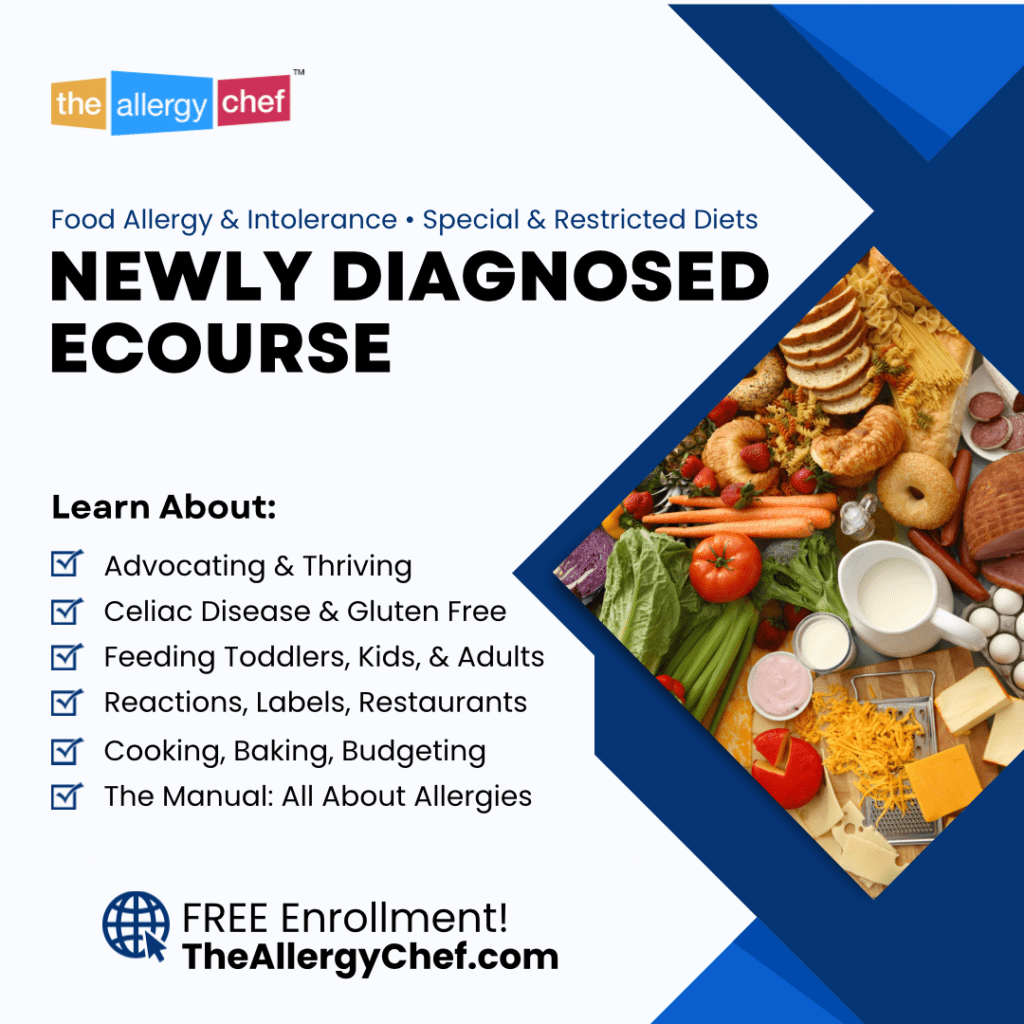 |
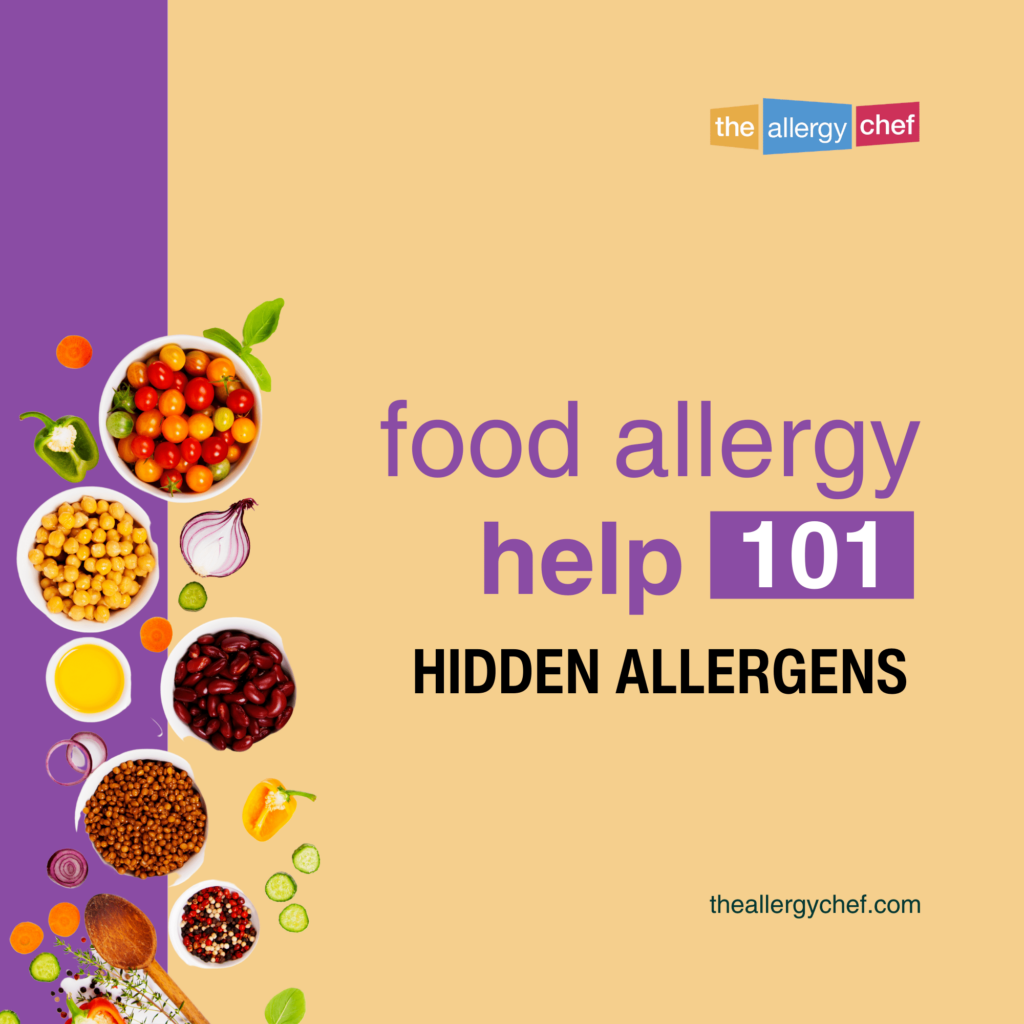 |
Milk and Dairy Definitions
When it comes to milk and dairy, you may hear terms such as:
- Lactose/Lactose Free
- Whey
- Cow’s Milk Protein Allergy (CMPA)
- Cow’s Milk Allergy (CMA)
- Casein
- Ghee
- Milk Fat
- Milk Solids
- Milk Powder
The conventional definition of dairy (where food allergies are concerned) is: food made from or containing dairy. The dairy can come from Buffalo, Camel, Cow, Goat, and Sheep.
In regular terms, when people refer to “milk”, 99% of the time they’re referring to cow’s milk, however, the can be referring to milk from several mammals.
What’s The Difference Between Milk and Dairy
An easy way to think about this: dairy items are made with milk. Think about the last time you were in the grocery store. Items such as milk, yogurt, sour cream, and butter are all sold in the dairy area of the store. They’re each made with milk.
In some cases it’s goat’s milk, sheep’s milk, or a different mammal, but all milk containing ingredients are grouped together in the dairy section of grocery stores.
Different Parts of Milk and Their Definitions
Casein: The main protein present in milk, cheese, and milk products.
Ghee: Clarified butter made from the milk of a buffalo or cow. Some feel this is “dairy free” since it’s the fat content and the protein is mostly removed.
Lactose: Lactose is a natural type of sugar and is present in milk (anything ending in ‘ose’ is a type of sugar). This is sometimes referred to as “milk sugar” and is not the same thing as condensed milk which is milk + cane sugar.
Milk Fat: Makes up about 3.7% of milk content.
Milk Solids: Milk is made up of about 13% solids, which is not the water content. The other 87% of milk is water content.
Whey: The watery part of milk that remains after the formation of curds.
If you’d like to learn more about dairy and read extensive definitions, check out this info from the International Dairy Foods Association.
Different Names for Milk Ingredients & Dairy Ingredients
These are the different names that absolutely mean MILK. I wouldn’t consider these hidden ingredients, but you need to be aware of all of the name changes milk can go through when it’s used in food products.
- Butter
- Buttermilk
- Caseinate (Sodium Caseinate and Calcium Caseinate, each is a derivative from milk protein, has a wide variety of uses including as a food additive)
- Cream Cheese
- Condensed Milk
- Cottage Cheese
- Curds
- Evaporated Milk
- Ghee
- Goat’s Milk Products
- Kefir
- Lactalbumin
- Lactoglobulin
- Lactose-Free Products (lactose-free milk, lactose-free cheese, etc.)
- Milk (whole milk, skim milk, etc.)
- Heavy Cream
- Sour Cream
- Whey Powder
Hidden Sources of Milk and Dairy
Now that you have a little primer on dairy and milk, let’s look at hidden sources of milk. I consider these sources “hidden” as most people wouldn’t think, “oh, that has milk in it”.
- Au Grain (a French term that can refer to breadcrumbs, grated cheese, or both)
- Baby Formula
- Baked Goods (biscuits, cookies, cupcakes, pastries, pies, etc.)
- Baking Mixes (bread, brownies, cake, cookies, pancakes, gluten free mixes, etc.)
- Bread (gluten free breads as well)
- Broth
- Caramel (sauce and soft candies)
- Carbonated Drinks & Sodas (a lot of brands, including fancy probiotic sodas are made on shared equipment with milk)
- Candy & Sweets (nougat, truffles, bark, etc.)
- Canned Tuna (this isn’t commonly seen, but some brands contain casein)
- Cereal (both wheat and gluten free cereals)
- Cereal Bars
- Cheese Flavored Snacks
- Chocolate (items containing chocolate usually have milk mixed into the chocolate)
- Crackers
- Coffee Creamer
- Creamed Vegetables (creamed spinach, etc.)
- Custard
- “Dairy Free” Cheese
- “Dairy Free” Ice Cream (some are lactose free only, some sherbets are an issue as well)
- Deli Meats & Lunch Meat
- Drink Mixes
- Eggnog
- Frosting
- Fudge (both chocolate fudge products and non-chocolate fudge products)
- Granola Bars
- Gravy & Sauces
- Instant Potatoes and Instant Mashed Potatoes
- Korma (lamb korma, fish korma, etc.)
- Margarine
- Medication (both Rx and OTC medications)
- Muffins
- Paneer
- Potato Chips (usually found in flavored chips rather than plain sea salt)
- Protein Bars
- Protein Powders
- Pudding
- Recaldent (a milk protein ingredient found in some chewing gum)
- Rennet (some rennet is vegan these days)
- Salad Dressing (including popular salad dressings like Ranch dressing and Caesar dressing)
- Sausages & Hot Dogs
- Sherbet
- Soups (not just “cream of” soups, but other soups as well)
- Supplements & Vitamins
- Vegan Products using Lab-Grown Milk Proteins
- Yogurt
A Bit More About Chocolate and Cross-Contact
Terms such as milk chocolate, dark chocolate, and semi-sweet chocolate all indicate the items will contain milk. Furthermore, I have it on good authority from someone within the chocolate industry that if you’re allergic to milk, peanuts, or tree nuts, you should never purchase chocolate that’s processed on shared equipment with those allergens. The equipment can be difficult to clean from all residue, and the risk for cross-contact is high.
The great news is that dairy free and milk free chocolates are available at grocery stores nationwide. If you’d like to see a list of dairy free candy options, check out this article on gluten free and allergy friendly candy.
Hidden Milk in Low Calorie Foods
Simplesse is a fat replacer made from egg and whey. It’s sometimes found in low calorie foods including low calorie ice cream, yogurt, mayonnaise, cheese spreads, and more. Since this is a brand name product that’s used in the food industry, you probably won’t see it listed on an ingredient label. Instead, you’ll see things like “whey protein”.
Just be aware that it’s out there, in case you *do* happen to see it as part of an ingredient list.
Hidden Milk and Dairy in Non-Food Items
Like gluten, (parts of) milk can also be found in non-food items. This becomes an issue for people who are contact allergic to milk. Some examples include:
- Adhesives
- Bath & Body Products (shampoo, bath bombs, toothpaste, etc.)
- Hand Sanitizer (I KNOW!!)
- Paint
- Industrial Materials
These products won’t be labeled the same as food products, so you’ll need to get in touch with manufacturers to find out if there’s milk or dairy ingredients in their products.
Hidden Milk & Dairy in Restaurants and Fine Dining
In restaurants and fine dining, milk is everywhere, and I don’t say that lightly. Butter is like water in some restaurants, and it’s touched everything onsite. To find out if a restaurant has something safe for you to eat, start by visiting their website and looking for an allergy menu.
From there, call and talk with a manager or chef. This article on dining out with food allergies can help you understand the types of questions you’ll need to ask. Also check the apps Spokin and Allergy Eats. There are user generated reviews on different restaurants, all over the world.
Places you wouldn’t expect to see milk: steak, and cocktails. Fancy drinks can contain milk, in fact there’s a trendy new vodka made from sheep’s milk. Additionally, it’s very common to baste steaks in butter with aromatics such as rosemary. You’ll need to ask about these types of details before dining out.
Butter is also a very common ingredient in gravies and sauces. The thing about eating at restaurants: most of the food is made in advance. In fact, in some cases, it’s made offsite and trucked in. What that means is that at some places their ability to serve you safely is severely limited.
You may be able to ask for steamed rice and a side of fruit at some locations, but even then, still ask all of your questions.
How You Can Avoid Milk and Dairy
One of the best tips I can ever give someone who’s new to food allergies it to shop brands that are made by the free-from community, for the free-from community. When people who have walked a mile in your shoes are the ones starting the companies, they just get it. They walk the walk and understand how to make truly safe products.
The next thing to do is to make food at home from naturally dairy free foods (fresh meat, fresh produce, rice, basic grains, etc.). When you do this, you don’t have to worry about a lot of things.
When you’re new, you may want to avoid products made in shared facilities and/or on shared equipment with milk. There have been several recalls as of late for undisclosed milk. Honestly, this terrifies me the most, which is why in our home, shared equipment food is a no-go for my kid with a milk allergy. Many of the recalled products are probably things you’ve never heard of, but a couple were from brands that specifically market to those who are dairy free.
RAISE (membership website) has legacy Safe Product Guides that offer great leads on products made on dairy free equipment. Additionally, you can tap into the Spokin and Fig apps for more product leads.
How to Check Labels For Dairy and Milk
Here in the U.S. and around the world, anywhere that recognizes major allergens has milk as one of said allergens. In the United States, we have the top 9 allergens (wheat, milk, egg, soy, peanut, tree nut, fish, shellfish, and sesame). There’s also the food labeling law that works to your advantage.
In food products, if any part of milk has been used, it must be called out on the label either in bold or in a contains statement that’s near the ingredient list. You may see something like: Contains: Egg, Milk, Peanut
Every so often, a label gets things wrong, so you should never 100% rely on those statements. Always read the label. If there are a lot of ingredients, (or the print is especially tiny) one of the best ways to make sure you don’t miss anything is to use your pointer finger to guide your eyes along each line.
You’ll want to look for the milk ingredient terms I listed above in this article, ingredients including: milk, powdered milk, casein, ghee, lactose, whey, and whey isolate. Those are the terms you’ll most likely see.
Reading Food Labels When You Have a Milk Allergy & How to Find Hidden Milk and Dairy on Food Labels
Milk is considered a major allergen here in the U.S. and around the world (top 8, top 9, top 10, top 12, and top 14). Food labels should clearly indicate if milk is an ingredient on the ingredient list of the package. You’ll either see the word milk in bold on the label, or you’ll see a “contains” statement. It will say something like “Contains: Milk, Soy“.
Here in the U.S. and around the world, there’s a lot of details that aren’t on food labels. That includes:
- If the food was made on shared equipment with milk.
- If milk is present in the manufacturing facility.
- If the raw materials came into contact with milk in any way including storage.
You may also see terms on the label such as:
- May contain traces of milk
- Made on shared equipment with milk
- Processed in a facility that also manufacturers milk ingredients
These are voluntary disclosures which is why you’ll see them sometimes, but not all of the time. This free Food Allergy Help 101 Course on Hidden Allergens can explain in greater detail what all of this means.
Before consuming products, it’s important that you call/email to learn more about the sourcing of raw materials, how the food is processed, stored, and packaged. Each step in manufacturing can expose the product to something you’re allergic to, including dairy.
Some companies are putting their best food forward by creating pages on their website that list all of these details for each product. A great example of this is Simple Mills. Others aren’t great at listing their protocols and you will need to get comfortable calling companies.
The good news is that companies keep good records and details about major allergens. Since milk is a major allergen here in the United States and abroad, you should be able to contact a company and get detailed answers. Manufacturer’s can also reach out to their supply chain from start to finish to make sure milk isn’t present.
There Could be Milk in Your Maple Syrup
The thing about hidden dairy is that that some of it won’t be on the label. For example, cream (milk) can be used as a defomer in maple syrup production. IT’S NOT ON THE LABEL. It’s a processing aid.
This is really what finding hidden dairy in food and hidden milk ingredients is all about. It’s understanding HOW something was made, the equipment, and much more. You’ll need to go to this extent of investigation if you (or the person you manage) cannot tolerate trace amounts of milk.
If you want to learn more about what is required for companies in terms of labeling for food allergies, I recommend familiarizing yourself with the FDA guidelines. Just know going in, there are loopholes.
Cross-Contact: What Is It?
Cross-contact, which some people incorrectly but also technically correctly call cross-contamination, is something everyone with a food allergy needs to know about. It’s important that you use the terms that are used in the food service and food manufacturing worlds, not how you’ll see people use it on the internet. If you don’t use it properly then try to communicate, professionals will be confused.
Cross-Contact: This refers to allergens specifically. If a chef uses a spoon in the gravy containing butter (milk), then transfers the spoon to the dairy free sauce to sample. In this case, a pathogen was not transferred because the gravy is cooked. An allergenic protein however was transferred.
Cross-Contamination: This refers to pathogens, bacteria, and food borne illnesses.
Example: a chef places raw chicken on a cutting board to prep it for service. After completion, raw celery which will be served raw is placed on the same cutting board. There’s contamination from the raw chicken and can cause a food borne illness via the celery that touched the board.
The issue with these terms is that *technically*, cross-contact is indeed cross-contamination. If you eat something contaminated with milk, it causes a food borne illness in you. Yet, that’s where we have to focus on the terms pathogen and allergen. That will be the defining feature of these cross terms.
Now that you know the difference, make sure you use the right term when you communicate with companies and restaurants. Chefs and wait-staff especially will be confused if you use the wrong terms because they’ve been trained with pathogen vs allergen.
If you’d like to read a lot more about cross-contact, all the ways it can happen, and how to prevent in your own home, check out this article.
High Risk Cross Contact Foods
As I mentioned earlier, chocolate products have a high risk for cross-contact, and that’s because of the residue that’s left on the equipment. Here are other food products that carry a high risk for cross-contact.
Grocery Store Deli Meats. Pre-package meats aren’t usually the issue here, rather, when you go to the meat counter in grocery stores and they slice deli meat for you from behind the counter. Those meat slicers are very often shared with cheese as well. You’ll need to ask about the meat slicer, and if it is indeed shared, I’d strongly encourage you to purchase something else.
Sandwich Shops. They’ll have the same shared slicer issue, as well as shared grills and so on. Unless they have a dedicated space for preparing allergy free items, I wouldn’t eat there.
Restaurants That Use Non-Stick Pans and Cast Iron Pans. Something most people don’t realize is that “non-stick remembers”. A lot of these pans are hand wash only, especially in the case of cast iron. Additionally, if a pan is scratched, allergens can hide out in said scratches (the same is true for cutting boards). Anything that’s hard to clean can also pose a risk for those with food allergies.
Dairy Free Ice Cream. DF ice cream and popsicles made on shared equipment with milk have a higher risk of cross contact due to the type of equipment that’s used and the residue that can be present.
Dairy Free Milk. I’ve called almost all manufacturers of dairy free milk, and just about every one has told me their milk is made on shared equipment with milk (and other major allergens). Personally, I opt to make milk at home for my child with a milk allergy because there’s SO much peace of mind.
Diet Types & Cuisines
Most major cuisines will generally include milk as an ingredient. When eating out, always ask to see an allergy menu. You should also call ahead and make sure they can serve you safely. There are some diet types that are naturally milk free. If you can find a restaurant that exclusively caters to these diet types, you may find eating out to be much easier.
For some, you’ll still need to ask about raw material sourcing, and for others, it will be a walk in the park.
Diet Types That Exclude Milk & Dairy
- AIP Paleo
- EOE Friendly
- FPIES Friendly
- Paleo
- Paleo-Vegan
- Top 9 Allergy Free
- EU Top 14 Allergy Free
- Vegan (with the exception of lab grown proteins)
One of the biggest tips I can give you when you’re new to the diagnosis: if you’re looking for packaged foods, look for food products that claim to serve those diet types listed above. Also note, vegetarian is not the same thing as vegan. The vegetarian diet types allows for milk and other animal products that aren’t animal flesh (such as eggs).
Have Nutrition Concerns?
When many people go dairy free, one of their top nutrition concerns is calcium. The great news is that there are plenty of other great sources of calcium and you can read more about that in this article.
Before running out to grab supplements, make sure you ask your doctor to run a full panel of labs to check on your essential vitamins, minerals, omegas, amino acids, heavy metals, and more. These tests will help you understand your baseline, and what (if anything) needs improving.
If you’re struggling to make a meal plan full of delicious meals that meets your needs, you can book a 1-on-1 consultation with someone like myself, or ask for a referral to an RD. Chefs and dietitians are able to help you put together plans that can meet not only your needs, but the needs of your household so you can cook once and serve everyone.
Further Reading & Resources:
Want to dig even deeper? Awesome! Here are more resources to keep you informed.
- The Dairy Free Diet: Things to Know When You’re Going Dairy Free
- Dairy Free & Milk Free Swaps
- Spokin App: a personalized app for info on food allergies
- Allergy Eats: an app to find places to eat out, based on user generated reviews.
- SnackSafely.com offers a product guide to get you started.
- Go Dairy Free has a great page on hidden dairy.
- Kelly Mom has a handy pdf with more items to avoid.
Answering Your Hidden Sources of Milk and Dairy Allergy Questions
Does mayonnaise contain milk or dairy products?
Usually no, but low calorie mayonnaise can contain milk protein (whey). When in doubt, look for organic mayo, or Paleo mayonnaise, as these are much, much less likely to contain milk derivatives.
Is there a brand that sells dairy free salad dressings?
The brand Dayia is a favorite of the dairy free community, so I’d start there. Also look at Paleo salad dressings, especially if you like cleaner ingredients.
Do hot dogs and other processed meats contain milk products?
Sometimes yes, hot dogs, deli meats, and other processed meats can contain milk. If milk is one of the ingredients, it should be listed, however, it’s always a good idea to check with the manufacturer as well. I’ve had a great deal of success with the Applegate brand of processed meats for my child with a milk allergy (and anaphylactic reactions).
Does sorbet contain milk?
By definition, no, sorbet shouldn’t contain milk. However, it can be made on shared equipment with milk, and the cross-contact risk will be high. Sorbet should only contain water, sugar, and fruit, but these days with everyone wanting to be cutting edge, you may find a sorbet with extra ingredients. Nonetheless, the manufacturer should be able to give you all the details of their sorbet.
Only my toddler is allergic to milk. Is it easier (or better) to have the whole family eat milk free as well?
Yes and no. Little kids get into *everything* including the crumbs on the floor. If you have milk containing foods and their crumbs all over your home, it can be a risk for your toddler. On the other hand, free-from foods are expensive, and not everyone enjoys the taste.
Personally, I kept a tight lid on everything so that milk ingredients could be in the home, but essentially had three kitchens, and a LOT of duplicate cooking utensils and appliances.
It’s going to come down to what makes the most sense for you, and also keep in mind, you can change at any time. If you find that now it’s good for everyone to be dairy free and when your toddler is five you’ll switch, that’s OK too. Just make sure you’re teaching your family how to keep the space clean for your toddler, and do a great job cleaning up after cooking and dining together.
What are the best butter substitutes for making cookies?
First, know that all dairy free butter substitutes are a 1:1 exchange in cooking and baking. Due to food allergies of my taste testers, I haven’t been able to use more than one brand, and everyone seems to be OK with that. I’ve used Earth Balance for years, and when needed I’ve also used organic palm shortening.
Honestly, if I could, I’d buy a container of all the diary free butter substitutes and do a head to head bake to see which really is the best. If you end up doing this, let me know what your results are 🙂
Do I have to do a food challenge?
A food challenge, sometimes called an oral challenge (or even food trials), is entirely voluntary. Neither you nor your child have to do a food challenge if it makes you uncomfortable. Know that these are done under the supervision of your medical team, and they can intervene if there are signs of an allergic reaction.
I will say this: I’ve met adults who were put through countless food challenges and allergy tests as children. Their parents would test and test every year, and the child wouldn’t pass. They’ve told me as adults that they hated those tests and felt like a failure because they didn’t pass and their parents were disappointed.
Are all parents like that? No. Of course not. However, keep in mind that kids internalize things and if you’re constantly testing a child for food allergies, it can have a lasting effect on them.
If I go through OIT for egg and milk allergies, will I be able to eat them safely?
OIT (oral immunotherapy) is never guaranteed to work. In fact, when someone passes, we say they’re “in remission”, not cured, as there are no cures for food allergies. Know that results vary from one individual to the next because this is all a science of the immune system. Since no two people are the same, it’s impossible to predict 100% of the time how individuals will respond to OIT.
I’ve known of people who could never get pass the first OIT dose, and those who live in full remission. However, the thing about OIT that people don’t talk about enough is that just how you can gain tolerance, you can lose it as well. I’ve also met people in this boat where they passed OIT, then a few years later woke up one day and had a severe allergic reaction.
Additionally, those with EOE have a higher risk of developing more issues if they undergo OIT. This type of science is, in my opinion, poorly understood, and all you can do is do your best and work with the information you and your medical team have.
Really assess OIT and what it can do for you, and what your goals are. If the risk seems worth it, as an adult, I say go for it. If you’re managing a child, it’s different because of consent. It’s really important that they give fully informed consent before you introduce known food allergens to their system (something a lot of parents overlook). This is doubly true if your child has a complex case. I’ll also mention, since we’re talking about treatments, look into TIP as well, as that may be of interest to you.
Is soy milk a good non-dairy milk to cook and bake with?
There are loads of non-dairy milk alternatives available, and soy milk is indeed a good one to cook and bake with. It will give your sweet and savory recipes a nice texture, and shouldn’t cause any issues. Be sure to get unsweetened soy milk for best results, especially in savory recipes.
Also know that in baking, soy milk is a little different than other non-dairy milk options and that’s because of the protein content. It’s not a bad thing, and some people prefer it for this reason. Overall though, all non-dairy milk options, with the exception of full fat coconut milk, are 1:1 substitutes for one another.
If however a recipe calls for a specific milk product (heavy cream, 2% milk, etc.), you may need to tweak the recipe a bit. This article on dairy free substitutes and how to use them can be super helpful.
Is a milk allergy the same thing as a lactose intolerance?
No, a milk allergy and a milk intolerance are two different things. Whilst they both involve the immune system, an allergy shows symptoms (usually) within immediate ingestion to four hours. Outside of that window, it’s suspected that you have an intolerance.
Additionally, a milk intolerance can’t lead to anaphylactic shock since it’s not IgE mediated. You can have a whole host of other reactions though including stomach cramps, severe digestive pain, painful bloating, skin issues, congestion, mucus issues, migraines, and a whole lot more.
A lot of people incorrectly think that a food intolerance is not as serious as a food allergy. Just because you don’t need an epi-pen doesn’t mean you take it lightly. A food intolerance, especially over time, can cause compounded health issues. So, no matter which boat you fall into, make sure you’re diligent and avoid milk.
I have a milk allergy. Will my baby have a milk allergy as well?
No, a family history doesn’t guarantee that your child will also have a food allergy. It doesn’t exclude them either. Also know that even if both parents have food allergies (even to the same foods) and their child is born with food allergies, said child may not have the same allergies as the parents.
Since there are a wide range of causes for food allergies, prevention isn’t cut and dry. Whilst you’re not able to have milk in your diet during pregnancy, I’d encourage you to take a look at the LEAP study. It’s one of the best studies for food allergy prevention in babies if you ask me, and it can give you ideas on how to take the next steps, especially when you’re introducing solids. Whilst the LEAP study is peanut specific, you can draw conclusions for other allergies as well.
Is eczema a symptom of a milk allergy?
Eczema is a common milk allergy symptom in infants, babies, toddlers, and sometimes adults as well. However, eczema can be linked to other health conditions, so if you suspect a food allergy, make an appointment with your doctor for testing.
I’d also encourage you to read information from allergists who specialize in eczema, such as Dr. Ratika Gupta.
Is butter flavor dairy free?
If you see butter flavor or artificial butter flavor on an ingredient label, it’s safe to assume that there’s some kind of milk derivative involved. You can contact the manufacturer for more information, but I’d avoid the product until you know more.
Are milk free baby formulas available?
Yes, there are milk free baby formulas on the market. The Baby’s Brew has a whole page about baby formula and infant formula that’s milk free and also top 9 allergy free as well.
If I’m breastfeeding a baby with a milk allergy, will I need to stop eating milk ingredients as well?
Usually, that’s advised as proteins can transfer from your breastmilk to your baby. Each doctor will have a different recommendation, but ultimately, if your baby is still showing signs of an allergic reaction (refusal to sleep, odd behaviors that you know aren’t right, bloody stools, skin issues, and so on), eliminate all milk from your diet and monitor your baby for signs of improvement.
Where you can, take photos to document things such as skin issues so you have a baseline to compare to later on.
Do we really need a medical alert bracelet for our child with a milk allergy?
I’ll be honest with you: most people with food allergies don’t wear a medical alert bracelet. It’s more common for people with a history of severe reactions to get an alert bracelet.
Whilst the avoidance of dairy will be your number one tool in keeping your kiddo safe, a bracelet can’t hurt, especially if they’re under the age of ten. The younger a child is, the less able they are to advocate for themselves, and their bracelet can help them communicate their needs.
A medical alert ID is also there for worst case scenarios: where your child is unconscious and their parents (or anyone else that knows about their allergy) is there to advocate. Ultimately, you’ll need to assess your lifestyle and see if a bracelet fits, but at the end of the day, it’s not a burdensome item to wear.

